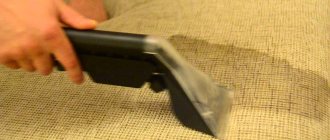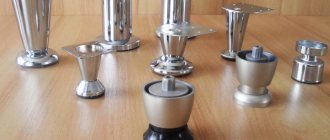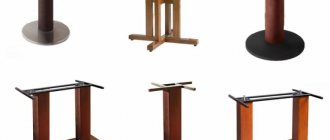Rearranging furniture is a difficult and time-consuming task, especially if these are massive objects like a wardrobe or a bookcase. As a rule, it’s too lazy to empty shelves of contents and remove doors, so in our material we will talk about both modern and “old-fashioned” methods of moving furniture around the apartment.
Of course, the simplest solution may be a team of movers who, at your request, will move cabinets all day long, but this is very expensive. You can call friends and acquaintances for help, but they are unlikely to be pleased with this prospect. In our material we will tell you about tricks and techniques that will help you move a heavy cabinet or chest of drawers alone.
Methods for fleecy surfaces
To avoid tearing the soft covering, roller devices or sliding materials are used to move a large cabinet. Before you begin rearranging, the furniture must be prepared:
- completely empty the closet of things;
- remove removable elements (shelves, rods);
- secure the flaps with tape.
Furniture conveyor
The device consists of a lever for lifting furniture and four rotating platforms equipped with rollers. The tool set is sold as a set or rented. The lever is made of durable steel, so it can withstand any weight.
With this device, a person will be able to move the cabinet without assistance. It’s easy for even a girl to master. With the help of a home loader, the corners of the cabinet are lifted one by one with one hand, and the platforms are positioned with the other. Next, the furniture is silently transported to the desired location. The platforms are removed according to a similar principle.
A mobile conveyor is a convenient tool for constantly moving heavy furniture.
Special furniture stands
They are represented by round parts made of smooth plastic of various diameters. Each element is attached to the cabinet with glue, screws or nails.
If you plan to use an adhesive base, it is recommended to secure the structure with a strong cyanoacrylate-based fixing compound. Rubber adhesive may not be able to withstand the load.
Garden type hand cart
Metal garden tools are suitable for transporting small bedside tables and chests of drawers. To transport larger items, you will need the help of a second person. You can transport a wide cabinet alone using belts or wide elastic bands holding the opposite edge.
A special trolley is suitable for transporting small cabinets.
Regular food foil
A fragile sheet of foil must be folded in several layers and placed under the legs. The remaining free edges are wrapped in a circle. This simple life hack will ensure reliable fixation of the material. The method is applicable only for light cabinets, since the foil will tear under heavy weight.
Using foil to move furniture is not the best option.
Nylon covers
A simple method used by no generation. Suitable for cabinets with built-in supports. If the lid is placed under a structure without legs, the edges will be deformed under the chipboard panel and the furniture will not move.
Packaged milk packaging
Used bags are suitable for moving light items. Before starting work, the packaging must be turned inside out. The inside of the bags is coated with a composition containing paraffin. With the help of milk cartons placed on the legs, the furniture glides easily over the carpet. For heavier structures, you will need to fold the packaging in several layers.
Improvisation - put “socks” made from milk cartons on the legs of the closet.
A piece of fiberboard (hardboard) or old linoleum
Lightweight pieces of furniture can be easily moved using hardboard scraps or leftover linoleum. You need to place the material under the corners with the smooth side facing down. If you have a large enough piece of material, you just need to pull the free edge to move it. If the fragments are small, you will need improvised means in the form of ropes, belts, and elastic bands.
Wooden rolling pins for dough
If you have an assistant, you can use three or four wooden rolling pins. This method has been used since ancient times, only then round logs were used. It is necessary to lift one edge of the furniture and place rolling pins. While moving, you need to move the released rolling pins again under the cabinet. With coordinated work, two people can complete the task in 2–3 minutes.
Ways to move a cabinet
Anyone who has had to move heavy furniture without assistance knows that this requires skill and a lot of strength. To make the cabinet slide freely, you must first move it from its resting place. To do this, you should completely empty the wardrobe of things, removable shelves, and secure the doors. To carry out a quick, simple cleaning of the room, wash the floor with any detergent to obtain a clean, free surface.
Adhering to the simple laws of physics, the cabinet begins to move when the points of contact between the surface of the floor and the bottom of the furniture are minimal, the flooring is smooth, and the product is empty. Taking this into account, the sliding of an object along the base of the room increases significantly, without causing damage to the floor covering. You can speed up the movement of a heavy cabinet on a flat floor to the right place using simple improvised means.
Raw potatoes
The simplest and most affordable way to move a cabinet is the well-known and beloved potato. The raw root vegetable is perfect as a sliding substrate on floors covered with laminite, linoleum, or parquet. Potatoes, depending on the tactics used to move the cabinet, are cut in two ways:
- circles 5 - 7 mm thick;
- into two parts.
By distributing the chopped root vegetable under the bottom of the cabinet, where the halves are placed cut side down, it can be easily moved around the room. The starch contained in potatoes, without leaving scratches on the floor, is a good lubricant for sliding. Remaining traces of starch can be easily removed with a damp cloth.
Wool rug
To make moving furniture easier, use a thick wool or felt rug. Despite the fact that this method is considered effective and does not require much effort, the preparation process itself is considered labor-intensive. It will take at least two people to tilt the cabinet back and pull the fabric underneath the base.
By evenly distributing the fabric, you can quickly move the cabinet across parquet and laminate floors. With light hand efforts, you can successfully pull it across the threshold of the room, while protecting the floor from scratches and damage to furniture. In addition to the rug, you can use a camel blanket or wool blanket.
Wool rug
The cabinet must be raised and a rug placed under it
Nylon covers
One of the most common household items found in any household will help reduce friction when moving furniture - plastic covers. Soft, flexible substrates lubricated with wax or soap easily fit under the base of furniture and ensure smooth sliding.
Slightly lift the heavy cabinet and place the required amount of lids under the bottom and move it around the room with minimal effort. This simple device is reliable and extremely safe for any type of floor covering. As an alternative, milk bags made of high-strength polyethylene film, characterized by a high degree of slip and strength, can be used.
Nylon covers
Paraffin, wax and laundry soap
It is no less effective to move a piece of furniture using paraffin or wax, which are irreplaceable items in everyday life and reliable helpers in difficult situations. Products used as a lubricant form a thin, strong layer on the surface, ensuring easy gliding. All you need to do is rub the floor with paraffin, wax or laundry soap along the previously outlined lines of movement.
The floor should be rubbed with wax or laundry soapFurniture conveyor
Today, to make it easier to move heavy pieces of furniture, a special device has been created that allows you to independently solve the problem of rearrangement without physical costs or the services of loaders. With the help of a furniture conveyor, which is easy to maneuver, even in the smallest rooms, you can:
- move an item to any location;
- protect walls, floors, cabinets from impacts and scratches;
- save time on rearrangement;
- move quickly on any floor covering;
- move furniture with maximum weight.
The operating principle of a home mover is simple. The hardened steel lever with rubber handle lifts cabinets of any size and weight. Transport platforms with rotating platforms on eight wheels are placed under each corner of the product. The furniture is transported silently, neatly and quickly to the planned location in the room.
Furniture moving kit
Moving furniture using a conveyor
Mechanical means
Nowadays, there is a wide variety of technical means to make work easier. To transport goods, you can use different devices.
Furniture conveyor
The device is a modern solution to the rearrangement issue. Using a small jack, you need to lift the edge of the furniture and place a platform with rotating wheels under it. This model will allow you to quickly and easily roll the cabinet around the apartment.
Stands with wheels
Perfect for a situation like this. In the case of heavy objects, it is better to use sliding stands mounted on built-in nails. Place them on the bottom of the structure to drag it.
Ways to move a heavy cabinet
Moving bulky pieces of furniture requires a lot of strength and skill. It is especially difficult to move massive chests of drawers and cabinets without legs when there is nothing to grab onto. The problem could be solved by hiring loaders, but this method is very expensive. You can do it on your own if you use some tricks. First of all, you need to do a little preparatory work, namely:
- Empty the product from its contents. A wardrobe or bookcase already has a lot of mass, and things add extra weight to it. Also, during the rearrangement, something may fall out, this will complicate the already difficult work. When putting things away, arrange them so that they do not interfere with transportation in the future.
- Remove removable shelves, drawers and rods. Of course, there is no need to completely disassemble the entire structure; you just need to lighten it as much as possible.
- Secure the opening doors (otherwise they will interfere at the most crucial moment). You can use regular masking tape.
- Wash the floor thoroughly with any cleaning product - this will not only make moving a heavy cabinet easier, but will also reduce the risk of damage to the floor covering.
After all the preparatory work, proceed to the main task. Some methods can make it much easier to move a heavy cabinet to the right place. The following will be a description of popular methods, just choose the best option for your case.
Using raw potatoes
One of the simplest folk recipes is the use of ordinary potatoes. The fresh root vegetable, which contains starch, provides slip and allows you to move heavy objects without causing damage to the floor. The cabinet can be moved using this method on the following floor coverings:
- laminate;
- linoleum;
- parquet;
- plank floor (only if there are no large gaps or differences between the elements).
To carry out the work, the tubers are thoroughly washed and cut into circles approximately 1 cm thick (the most common option) or cut in half.
To rearrange the cabinet, you need to slightly lift it and place potato pieces under the bottom. If the product is too massive, you should make more pads so that the cabinet does not simply crush them. Next, carefully move the structure to the desired location, remove the potatoes and wipe off any wet marks. Similarly, you can use lard skins by placing them at the corners of the cabinet. True, at the end you will have to thoroughly wash the parquet to remove any remaining greasy marks and specific aroma.
Using a wool rug
Another “old-fashioned” method is to move bulky furniture on a blanket or thick woolen rug (it is recommended to use old things so as not to worry too much about them during the process)
By carefully distributing the fabric under the cabinet, you can move it without much effort, while protecting the parquet from scratches and the product from possible damage.
Apply wax or soap
You can move a heavy object relatively easily using some available tools:
- laundry soap or soap solution;
- paraffin or wax.
Carefully rub the floor along the intended path of movement so that a visible layer of lubricant forms on the surface, ensuring sliding. After completing the work, everything can be easily washed with warm water.
Furniture conveyor to help
Not long ago, a device appeared for heavy shelves and chests of drawers, which consists of a special jack for lifting furniture and small stands with wheels. Thanks to this invention, you can independently, without outside help, transport the cabinet to the desired location and at the same time:
- save time, nerves and health;
- do not scratch the floor and protect the piece of furniture from chipping;
- move furniture on any surface, including deep-pile carpet (to do this, you just need to choose a model with large wheels);
- save on the services of a loader - it’s easier to purchase a small set once and use it for a long time than to call a team each time and pay a lot of money, in addition, in many cities you can rent a transporter.
How can you easily and quickly move furniture without scratching the floor?
On linoleum
Linoleum, despite its strength and flexibility, does not tolerate rough handling: it is easily scratched, compressed, and torn by the legs of heavy cabinets. What can be done?
- You can completely disassemble the structure: not just take out all the things from it, unscrew the shelves, but disassemble the entire structure into its component parts. True, this takes a lot of time, and if you frequently disassemble/assemble furniture, it will quickly deteriorate.
- The second option is to use special devices. They are like carts on wheels - they are called rokles. Sold in sets of 4 pieces, there is also a device resembling a jack.
- Option number three is multifunctional universal silicone grease WD40. You should wet the legs with it and move it in the right direction - easy gliding is guaranteed. Use any degreaser to remove grease from furniture and floors.
Attention: Invite an assistant to do the work: it is difficult to lift massive furniture alone to put something on it. But probably!
For laminate
You can use the same methods and means as when moving furniture on linoleum, or you can use a small rolling cart with nylon wheels and a comfortable handle.
It would be a good idea to purchase tie-down straps - wide polyester strips with a tension ratchet mechanism and fastening end fittings. They are elastic, lightweight, but durable and comfortable. Such tapes help to save a lot of time, while less physical effort will be expended than without them.
Free up the space where you plan to move the cabinet in advance . Clear the floor of large debris, move household appliances out of the way—in general, anything that might get in the way. Seal the doors with duct tape or tape (if you don’t want to remove them from the hinges): an opening door can hit you very painfully.
Features of moving furniture with legs
If the legs are long (at least 5 cm), you can move them using ordinary felt boots made of wool, thick and dense. They are put on each leg to drag the furniture where needed.
Advice: Honestly assess your physical capabilities, think through your actions in advance. Observe safety precautions: a careless attitude often leads to serious injuries not only to yourself, but also to others. Try to take a stable position, do not make sudden movements, do not try to do everything quickly.
Without legs
Surprisingly, it is true that some edibles can help. For example, raw potatoes. Cut the root vegetable into thick circles (5–7 mm each), place them on the floor with the cut side down. The cabinet can be easily dragged along such a slippery path thanks to the starch contained in the root vegetable.
If your closet is small, use jeans . The box should be placed on the “butt” and pulled by the trouser legs.
How to move a large wardrobe yourself?
A large wardrobe can be moved if you use the same rolling cart. This technique does not require special maintenance or additional assistants. The trolley is designed in such a way that it turns easily due to ball bearing discs, and can self-balance when driving on uneven roads.
How to remove dents on linoleum
Let's look at how linoleum is leveled when using the iron method.
Step 1. Before starting work, it is recommended to make sure that everything necessary for the procedure is in the house. You will need an iron (any iron, but preferably one with a steam function, that is, a fairly modern one), a roller for processing linoleum seams or a heavy weight, as well as ammonia and any fabric from which a layer can be made.
Roller for processing linoleum seams
Step 2. The iron is heated to maximum temperature
At the same time, it is important to observe safety measures - do not place the device on the sole on the linoleum itself, so as not to melt it, as well as on other surfaces that may be damaged or capable of catching fire
The iron heats up well
Step 3. Cotton but dense fabric is laid in several layers at the site of the dent on the linoleum. It’s good if before that it was treated with ammonia until it was slightly damp.
The fabric is laid over the dent
Step 4. The iron is placed on the fabric and pressed well against it - pressure should be applied to the coating. At the same time, the steam function can be activated.
The iron is pressed against the fabric
Step 5. The iron warms up the surface for about 30-60 seconds, after which the device and fabric are removed from the dent, and the edges of the defect are rolled with pressure with a roller.
The edges of the dent are rolled with a roller
Step 6. The cycle of heating and rolling the dent with a roller is repeated the required number of times. You need to understand that just warming up the dent is unlikely to disappear. It may take 10-15 warm-ups with an iron and rolling the defect with a roller.
Reheating with iron
Step 7. After completing the procedure, the dent may disappear completely or become barely noticeable. At least it won't be conspicuous.
As a result, the dent on the linoleum is almost invisible
Linoleum: material features
To fully appreciate the possibility of using various methods of moving furniture on linoleum, especially heavy furniture, it is worth familiarizing yourself with the characteristics of this material.
So, why do you have to be careful when moving any cabinet along the floor, which was finished with linoleum?
Due to its durability, flexibility and affordability, linoleum is very popular
Linoleum is a fairly durable, but at the same time flexible and even elastic material, which is now actively used for finishing floors in apartments, houses, offices and other premises. It is produced in large rolls of different widths, and the material itself can be either very thin or thick, with or without a backing. Modern linoleum contains polymer synthetic substances, most often it is made from PVC.
Tips for choosing quality linoleum
Linoleum on the floor looks attractive
Table. Parameters of modern linoleum.
| Linoleum parameter | Values |
| Width | 0.5-5 m |
| Length | 6-45 m |
| Thickness | 1.5-9 mm |
Table of main characteristics of linoleum
In fact, linoleum has several layers in its structure; it is not a homogeneous material. So, its top layer is a varnish coating that gives it shine. Next comes a protective layer, which prevents the appearance of the material from being spoiled as a result of exposure. The coating also has a decorative layer, thanks to which the linoleum acquires the color it has.
The structure of household linoleum
Structure of homogeneous and heterogeneous linoleum
Linoleum
Before we talk directly about moving furniture on a material such as linoleum, you should understand what kind of material it is and why you should be careful when carrying large items over it
Despite the general unpretentiousness of this coating and its time-tested reliability, it is important to handle the material carefully so that its service life declared by the manufacturer ends prematurely
Composition of linoleum
Linoleum is one of the popular floor coverings, which is produced in the form of rolls of various widths and is currently made most often on the basis of synthetic components. This material has a long history, if you go back to the very origins of its appearance. Initially, it was made on a fabric base, impregnated with ordinary vegetable oils - this format of the material dates back to the 19th century. In the 1950s, more modern types of coating were developed, which began to be produced on the basis of PVC.
Modern linoleum
Now the largest manufacturer of linoleum is the Tarkett company, which has factories in Russia. But the building materials market offers products from other equally well-known brands. What unites their products is the following: linoleum is produced in the form of large rolls with a width of 50 cm to 5 m, and the length of the canvas inside them is from 6 to 45 m.
Linoleum floor
In general, modern linoleum is not a homogeneous material; it consists of several layers:
- varnish top layer that gives the coating shine;
- a protective layer that prevents damage to the color and texture of the material;
- decorative layer (often made of PVC), responsible for the appearance of the coating;
- fiberglass - the base, a kind of “spine” of the coating, providing tensile strength;
- base made of PVC;
- sometimes the last layer of material is a fabric cloth, which increases the heat and sound insulation properties of the coating.
Linoleum structure
The flexibility of linoleum and its elasticity, heat and sound insulation properties, and density will depend on the PVC layer. It can be called the basis of the material.
Basic properties of linoleum
Despite such a large number of layers, linoleum remains a fairly soft and elastic material, which is quite easy to cut, easy to install, but at the same time very durable, not afraid of moderate mechanical impact and does not wear out.
Laying linoleum
Consequences of improperly moving furniture
Linoleum is characterized by increased moisture resistance and durability when handled correctly. It is easy to install and even an inexperienced craftsman can handle the task of installing it. But the material will last a long time only if it is treated with care. Thus, this material is characterized by low resistance to a number of mechanical influences. It is easy to cut or tear, burn. That’s why you shouldn’t just move furniture, especially heavy furniture, on the surface.
Typical damage to linoleum
If you drag furniture along the linoleum, not just folds, but torn holes are more likely to appear on it. A furniture leg can catch on the covering and tear it. There is no way to correct such a defect, unless you have to install a patch. But such a “fix” will still be noticeable in most cases.
Torn linoleum is a consequence of improper movement of furniture on the floor
By the way, if the house is furnished with furniture on legs, then you need to be prepared for the fact that dents may form on the covering in places where heavy interior items are installed, which are very difficult to fix. To prevent them from appearing, you will have to take care of protecting the coating even before installing the furniture on it.
Step-by-step instructions for repairing linoleum
Damage to linoleum
Cold welding of linoleum - stages of work
By the way, even if the material is not affected by furniture constantly moving over it, it deteriorates under the pressure of the legs of a heavy cabinet or sofa. In places where there is large or massive furniture, grooves form on the material over time - the linoleum simply sinks under things. And even if you remove a heavy cabinet from it, the holes formed in the place of the legs will not always straighten out again - a lot will depend on the duration of the mechanical impact, as well as on the quality of the floor covering.
Torn linoleum
Precautionary measures
When moving bulky furniture, it is important to protect yourself from possible injuries, damage to the interior and the structure itself.
Here are some recommendations:
- You should not move furniture without auxiliary devices . This often leads to damage to floors and deformation of the cabinet, injuries to the back, arms and legs.
- Before work, you need to clear the room of unnecessary items . Otherwise, you may trip and injure yourself while working.
- During work, you need to monitor whether the devices have slipped out from under the base , and correct them if necessary.
- Make sure your position is stable . Do not rush, make sudden movements or forceful jerks.
When a piece of furniture is too bulky and needs to be moved to another room through thresholds and doorways, you can turn to professional movers.
Yes, you'll have to pay. But this option guarantees the safety of the interior, furniture and, most importantly, health.
During the renovation, we were faced with the need to regularly move furniture from place to place. At first, they did not attach any importance to this and, as a result, some of the linoleum had to be re-laid due to damage from the wardrobe. It turned out that there are many options for protecting floors and they all work. We used a wool rug option, which made moving the furniture easier and protected the new coverings.
How to move or move a heavy cabinet
Moving a large object often damages the floor covering. Therefore, people have accumulated unique but practical recommendations that make work easier and protect linoleum from scratches.
Before moving you need:
- remove all contents;
- remove all removable structures: shelves, rods, if it is a compartment - doors;
- secure doors and pull-out shelves with tape;
- remove the mezzanine;
- move the cabinet a little away from the walls;
- wash the floor in the room.
When moving, it is better to work with three people - two move, and the third follows the direction.
Potato
One of the most popular and always available means of moving the cabinet is raw potatoes. To do this, you need to select large tubers of the same size, rinse and dry with a towel.
Potatoes are cut into slices 2 cm thick.
One side is raised slightly and potato discs are placed under the base. If the furniture is heavy, then the amount of potatoes is increased. After this, all that remains is to move the cabinet, which will slide easily due to the potatoes.
Some people recommend using lard instead of potatoes, cutting it into squares with skin.
The cabinet will also slide easily on the floor. But this is far from a practical option, and will require thorough washing of the floor from grease with soapy water.
Potatoes are cut into slices 2 cm thick
Wool rug
For this option you will need a wool rug or a piece of felt. It is optimal if its size is slightly larger than the base of the cabinet. But you can use 2-3 pieces.
The cabinet is raised and a rug needs to be laid under it so that it is located under all the supports. Two people work - one person pushes the furniture, and the other pulls the rug from the front.
Two people are needed to use the wool rug
Nylon covers
This method is only suitable for moving furniture with legs. To do this, rub the lid on the outside with paraffin and place it under each leg.
Milk cartons work roughly the same way. The inside of such bags is already treated with a composition that contains paraffin. Therefore, they are turned inside out and put on the legs.
This method is only suitable for moving furniture with legs.
Paraffin or wax
This method can be used on a flat and hard surface to move furniture over a short distance. Paraffin and wax are generously rubbed onto the surface on which the furniture will move. Wash the paraffin with a chloroform solution or warm soapy water.
A sliding surface can also be made using:
- glycerin;
- dishwashing detergent (Fairy, etc.);
- laundry soap.
Glycerin is applied in pure form, soap and detergent are diluted with water, slightly foaming.
You can also use WD 40 - a universal silicone lubricant. But first, the product is tested on a small area of the floor and washed off with any degreaser. If no traces remain on the coating, then it can be used.
This method can be used on a flat and hard surface.
Dough rolling pins
To move the cabinet you will need 4-5 rolling pins, which will act as rollers under the base of the cabinet. While moving, you need to constantly place rolling pins in front, removing those that the furniture has already “traveled” over.
Furniture conveyor
A very easy to use device designed to move furniture.
The kit includes a lever and 4 rubberized rollers on the platform. The cabinet is lifted using a jack lever and movable wheels are placed at each corner, which move in any direction.
Furniture conveyor
Felt pads
These pads are designed to be placed under furniture legs and bases to protect floors and provide structural stability. Sold in squares, circles and whole pieces. Each lining is treated with glue; all that remains is to remove it from the cardboard and secure it to the base of the furniture being moved.
Tips and Tricks
- Soft indoor slippers with dense foam soles will help you move furniture without damaging the floor covering. Slide them under your feet.
- Cut the skin off a piece of lard and slide it under the legs of the cabinet, skin side up. It is better to take young lard - old lard is not so slippery. The downside is that you will have to wash the floor thoroughly and for a long time. But washing doesn’t mean repairing again, right?
- A soft rug will also come to the rescue. It can be made of felt or wool: such material glides well. An old terry towel, a large blanket, or a camel blanket will do. But you will need outside help: lifting weights alone to pull the flap under its base is difficult.
- Another method from the times of our grandmothers was a soap solution. Dissolve a handful of washing powder or a quarter of soap (or a few tablespoons of any liquid detergent) in a bucket of water and wet the “path” in front of the cabinet. The furniture will “go” on it like on a skating rink. But you will need to act quickly, since the solution dries quickly, and moving very carefully means there is a high risk of injury.
- Polyethylene lids from cans or pieces of old linoleum left over after renovation are placed under the legs - quickly and easily. However, you will have to exert more force to move the cabinet from its place.
- If, by pure chance, there are several rolling pins lying around the house, they can also be used as a handy tool. They are placed one by one under the base of the box (in the direction of movement).
- Milk cartons are coated on the inside with a special composition that contains a lot of paraffin. Cut off 4 corners, turn them inside out, put them on the legs - the process will go faster.
- Food foil from the owner's cabinet is also an option. Fold a sheet of foil several times, place it under the legs, then drag it out. But you won’t be able to do this with massive furniture—the foil will tear.
- Wax and paraffin used as a lubricant form a slippery layer on the floor. You can also drag a cabinet along it.
Advice If there is a threshold on your way, we recommend placing a wide board of lumber 18–20 mm thick on it. The width of the board should be equal to the width of the opening and be convenient for rolling along its length.
Which method suits you best, choose for yourself. There are many options: you will definitely find the most convenient one for yourself.
Difficulties in rearranging furniture on your own
Property owners often do not know how to easily move furniture in their own apartment. Carrying out work independently without experience can lead to negative consequences, the main of which are:
- Damage to structural elements such as legs and door handles.
- Deterioration in the appearance of interior items due to scratches on the facade or side surface.
- Potential risk of tearing linoleum or carpet, scratching laminate or parquet.
- Possibility of damaging the wallpaper on the walls, chipping the corners of doorways or scratching the jambs.
- The most unpleasant situation can arise if the owner of the apartment did not calculate his strength and was injured. It’s very easy to hurt your back when lifting weights.
In order to avoid such negative cases, there are a large number of ways. Compliance with safety precautions, the use of special professional tools or folk methods help to rearrange interior items, regardless of the floor covering and without outside help.
Using a shoulder block
These are special lifting straps that fit over your shoulders and help relieve the strain on your back. When using them, the strongest muscle groups are included in the work, and additional leverage appears. As a rule, such devices can be purchased online.
Chicken cutlets with cherry tomatoes: signature recipe from actress Natalia Antonova
Russians turned their attention to Baikal, rediscovering it for themselves
Just lick your fingers. Omelet roll with mushrooms and chicken for breakfast
These types of devices with straps are not recommended for dragging furniture up stairs in any direction, since in this case almost the entire weight of the item will be applied to the person below.
Floor coverings to help move the cabinet
You can make the process easier by using a special coating that is placed under furniture to reduce friction.
Rug
A wool rug with a non-slip base should be placed with its pile facing the floor
to increase the sliding of furniture. At the same time, the non-slip base will not allow the cabinet to move off the coating.
Linoleum
Excellent for moving large objects. It is enough to slip a large piece of linoleum under the bottom of the furniture. If necessary, you can attach ropes for ease of dragging.
Old clothes
Another unusual way is to use old clothes with sleeves or long-legged trousers.
Take unnecessary items with soft pile or fabric. Place them under furniture. Now you can drag the sleeves or pant legs to put the cabinet in the right place. Since the weight may be too heavy, it is recommended to take several items at once.
Lubricant that can help
If you don't have any unnecessary things or suitable items on hand, a lubricating fluid will help to reduce friction.
- Regular soap solution . It can be made from soap crumbs and warm water.
- Vegetable oil.
- Paraffin or substances that contain it.
- Wax.
- A cleaning product that produces a soapy or foaming solution.
- Lubricant.
The options presented in this list help solve the problem equally well.
Carefully apply any of these types of lubricants to the floor. It is worth lubricating only the path along which you will move the furniture . After completing the work, rinse off the solution with warm water and wipe the floor dry.
Conveyor on rollers - how does this device work?
If you often have to move heavy furniture, then it makes sense to purchase a practical and convenient device – a furniture roller conveyor. It makes it possible to move cabinets, sofas and other heavy furniture without removing the contents from the inside, and adapts to any shapes and curves. The standard kit consists of a lifting arm and four platforms with rubberized backing and 360-degree rotating casters. The shape of the rollers may vary depending on the company. The companies POWERFIX and Bradex have proven themselves well on the Russian market. The build quality also affects the weight that the conveyor can support. The average load capacity is 100–150 kg.
The principle of using a roller conveyor:
- 1. Place the lever under the base and lift the corners of the furniture;
- 2. At each corner we place platforms (carts) with a round backing exactly in the center of the leg so that they do not slide off;
- 3. Roll the furniture to the desired location and remove the platforms, supporting the structure.
The main danger to your floor lies under the sofa: its legs or pull-out rollers can forever leave an indelible mark of their presence. Sensitive parquet and laminate flooring are especially affected, on which even small scratches and abrasions are visible. A sofa that does not scratch the floor will help to avoid the appearance of defects and maintain the beauty and integrity of the floor covering when unfolding.
It is easy to choose a sofa that does not scratch the floor: many modern models are equipped with convenient and safe mechanisms that allow you to avoid unpleasant consequences after unfolding. Let's look at the most popular of them.
Useful video
The video describes how to move a heavy cabinet:
Repair, rearrangement, relocation - what do these concepts have in common? No, not only the chaos in the house, the nervous state of those living there and the inspiring changes. Let's talk about something more mundane - moving heavy furniture. In particular, cabinets.
Moving such a colossus is not so easy. It can take a lot of time to unload the content, move it, and then load it back. Plus, there is always a risk of scratching the floor, breaking or dropping something.
To save time, some people move cabinets unassembled, which is even more difficult.
Call a special team? Loaders? Or try on your own?
Let's look at the last option.
So, what will help you move a heavy cabinet yourself.
Pieces of linoleum
You will need unnecessary pieces of linoleum, which are usually left over from repairs. If there are none, then you can buy a small piece in a specialized store.
It is better to take the pieces in a rectangular shape and long enough to place them under the cabinet. Moreover, the linings should be slightly longer and wider than the cabinet walls - so that it is convenient for them to correct the movement of furniture.
Pieces of linoleum should be placed under the cabinet. Then use rope, tape or masking tape to secure all the doors so that they do not open when moving the furniture.
Next, prepare a concentrated soap solution. Which wets the floor covering along the entire path of future advancement of the cabinet.
Then, by carefully hooking the edges of the linoleum and holding the cabinet itself, you can move it.
Read also:Types of sliding wardrobes: features, advantages, tips for choosing
Soft mats from household supplies
To prevent moving heavy furniture from seeming like a very difficult task, you need to ensure that its base glides smoothly across the floor. One of the simplest options is nylon lids for jars. Simply place a lid under each leg. The sliding surface will reduce friction on the floor and it will be easier for you to move furniture.
Nylon covers will help you move furniture
The threshold at the door often becomes an obstacle on the way. Overcoming it without the use of complex systems will also not be difficult. To do this, prepare a long woolen rug (rug) and place it under the base. Further actions - one person pushes the structure, and the other pulls the mat. A little effort and you will successfully overcome even the steepest threshold. An alternative to a wool rug is a damp cotton cloth. The fabric itself will protect the floor from scratches, and its moisture will increase slipping and reduce effort when moving.
Felt stickers can also be placed under furniture legs and will not scratch the surface. You can make them yourself, for example, from an old felt boot, or purchase ready-made backings in the hardware department. The underlays should protrude slightly beyond the furniture legs. The most difficult thing is to lay felt under the base: slightly raise the furniture or tilt it towards the wall. To avoid problems in the future, glue the backing to the legs. Instead of felt, you can also use rubber pads or pieces of linoleum. By the way, linoleum can be taken in a larger size, using it according to the principle of a woolen rug.
A combination of any of these methods with the use of soap or wax will help make it easier to move furniture around the apartment.
Old CDs can also be used as a sliding pad under each leg to move furniture across the floor with ease.
Tightening straps
If the cabinet has no legs, tensioning belts will help - elastic bands that have a tension mechanism and fasteners. They keep the cabinet suspended while you move it. The straps require two people to lift the furniture evenly on both sides.
To move the cabinet you need:
- Place straps under its bottom.
- Put the fastener on both people and secure it.
- At the same time, lift the cabinet and move it, holding it on the sides with your hands.
The load will be redistributed and moving heavy furniture will not be difficult.
Consequences of careless handling
But linoleum, no matter how reliable and durable it is, needs careful care and careful operation. The above-described elasticity and some softness hide those features of the material that do not allow it to be handled roughly. When moving heavy things on linoleum, it is quite easy to damage it. Under the pressure of the cabinet legs, it bends, gathers like an accordion and, as a result, breaks. Repairing the material will be either difficult or completely impossible.
Damage to linoleum
Cold welding of linoleum - stages of work
By the way, even if the material is not affected by furniture constantly moving over it, it deteriorates under the pressure of the legs of a heavy cabinet or sofa. In places where there is large or massive furniture, grooves form on the material over time - the linoleum simply sinks under things. And even if you remove a heavy cabinet from it, the holes formed in the place of the legs will not always straighten out again - a lot will depend on the duration of the mechanical impact, as well as on the quality of the floor covering.
Torn linoleum
Preparation
Try to make your work as easy as possible by first disassembling and emptying the furniture that you will move.
It is advisable not only to remove all contents from the cabinet, but also to remove shelves, rods and other removable elements. Seal the doors with masking tape or tie something to prevent them from opening.
If you need to move a straight or corner sofa, then remove pillows and other items from it, take out bedding from linen drawers.
Prepare the means at hand that will make it easier for your feet to slide. Their choice depends on the type of flooring.











